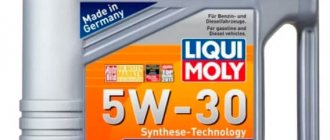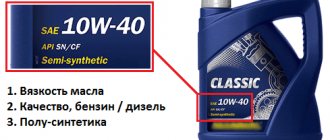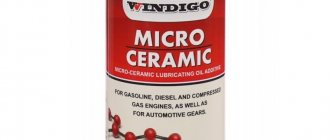With the onset of frost, many car owners are interested in the question of what oil to fill in for the winter. For different regions of our country, oils labeled 10W-40, 0W-30, 5W30 or 5W-40 are used. Each of them has different viscosity characteristics and minimum operating temperature. Thus, oil marked 0W can be used at a minimum temperature of -35°C, 5W - at -30°C, and 10W - respectively, down to -25°C. The choice also depends on the type of base oil. Since mineral lubricants have a high freezing point, they are not used. Instead, synthetic or, in extreme cases, semi-synthetic oils are used. This is due to the fact that they are more modern and have high performance characteristics.
Driving style
Particular attention must be paid to driving style and handling style.
We can say that if a car owner likes to push, then his car needs auxiliary protection. As soon as the engine gains high speed, it begins to heat up very much and the friction force between the parts increases. And if the oil does not cope, it will start to burn. The motorist should not be surprised if a lamp lights up on the instrument panel indicating a drop in oil pressure. He must regularly check the oil level in the system and, of course, change it periodically. It can be recommended to such car owners that it is necessary to use oils of the 5w50 or 10w60 classes.
Climatic conditions in different regions
An equally important factor when choosing motor oil is the region of residence and its climatic conditions. All of the above applies to the temperate climatic zone of the country: it is hot in the summer, and in winter there is no contact between teeth.
But if you live in the south, where there is not always snow in the winter, it is worth considering oils that are more oriented towards warm and hot weather.
What about those places where there are polar bears? From surveys conducted by both motorists and professionals operating vehicles in the Far North, we came to the conclusion that the vast majority use SAE 5W40.
The lower operating threshold is somewhat arbitrary, and you won’t be able to start the engine at minus forty without installing heating systems with absolutely any oil, so why “fence the garden”?
Particularly attentive and picky readers may notice why they made a reservation at the very beginning: “so-called all-season oils.” But we didn’t make a reservation. To make it clear what exactly we had in mind, here is a conversation between two car enthusiasts starting their cars in the morning.
One is already purring and warming up, the second is not at all. The upset owner asks the “lucky” one: “What kind of oil are you using?” The answer is fresh. It’s a joke, of course, but as you know, every joke contains only a fraction of a joke.
The word all-season has already played a cruel joke on many car enthusiasts. The fact is that if the oil is changed in the spring, by winter the engine crankcase will not contain the same product that you took off the shelf in the store.
It is difficult to say in what percentage these same properties are reduced per thousand, but if this were not so, there would be no need to change it. Right?
Changing engine oil in Ford Focus 2
Therefore, it is preferable to change the oil in winter. Such a simple rule will allow you to use all the declared characteristics to the fullest. And go into the summer with oil that is still quite suitable for mild operating conditions.
Classification of motor oils according to SAE
The international SAE standard, developed by American automotive engineers, provides for three types of engine oils: summer, winter and universal. Determining what type of liquid in a canister is is quite simple:
The labeling of summer oils includes only a digital designation. Moreover, the numbers are two-digit (10,20,30). They conventionally symbolize a high-temperature limit, exceeding which will cause a deterioration in the consumer properties of the working mixture. The high viscosity of the oil, intended for use in conditions of “plus” temperatures, under the influence of overheating reaches the required degree of fluidity and is distributed as efficiently as possible over the entire working surface. The use of summer lubricant in low-temperature conditions is prohibited due to the same viscosity: cold increases the viscosity of the liquid and does not allow it to function at the proper level.
Average oil performance ranges
winter engine oil is designated by the number 0.5,10,15 and the letter W. The number characterizes the range of negative temperatures in which the working fluid retains its properties. The letter W means that this motor oil can be used in winter. It has a high degree of fluidity, which allows you to instantly crank the crankshaft even in harsh climatic conditions.
Oil marked 0W is used at temperatures from -10 to -40 degrees Celsius, 5W - from -10 to -35, 10W - from 0 to -35, 15W - from +5 to -25.
universal oil contains the designations for summer and winter fuels and lubricants. In other words, the marking contains two numerical indicators and the letter W between them. Universal oil does not require inter-seasonal replacement, so its use saves car enthusiasts from unnecessary headaches. Such a liquid retains the required characteristics and parameters under conditions of sudden temperature changes. In addition, if the operating conditions of the vehicle require serious motor overloads, then all-season lubrication will most effectively protect all working components from rapid wear.
If you are a supporter of seasonal oil changes, then you should carefully monitor weather conditions. You cannot operate a car filled with summer fluid at sub-zero temperatures.
Oil filter VAZ 2107: what is it for and how to change it
We select winter oil based on its chemical basis
Motor oils may contain artificially derived or natural ingredients. If the working mixture consists only of petroleum products, then it has a mineral base. Mineral water is the first type of fuel and lubricant that was actively used before modern developments in the petrochemical industry. Unfortunately, it cannot boast of high technical characteristics: a large number of oil-containing components form carbon deposits and soot in the working area of the car, which significantly reduces its service life. New mineral fluid needs to be filled in every 5-7 thousand kilometers (provided that the car is used in quiet driving mode).
Comparison of synthetics and mineral water
This type of motor oil has a number of significant disadvantages, among which the impossibility of using them in the winter season should be especially highlighted. The fact is that the natural base of the protective liquid freezes at a temperature of -10 degrees Celsius, which means that mineral water is even dangerous for cars that are operated in harsh climatic areas. On a canister of mineral liquid you usually will not find symbols characterizing the type of its chemical base.
Semi-synthetic motor oil consists of 60-70% natural ingredients; the rest is made up of artificially created compounds. Such a mixture has a certain resistance to temperature changes, but its possibilities, alas, are not unlimited: the semi-mineral composition does not allow maintaining the stability of consumer properties in low-temperature conditions.
The best winter motor oil is synthetic. It can “adapt” to sudden climate changes and excellently retains its qualities over a long period of use.
Synthetics contain only artificially obtained substances that carefully protect the engine from overheating and freezing of the motor, and also remove dirt and soot from it that is formed when using low-quality oil.
So which engine oil is better for the winter?
Before choosing an oil, you need to thoroughly study its characteristics. Several criteria will need to be taken into account:
- Lubricant recommended by car manufacturers;
- Whichever car has mileage, it is known that for engines with high mileage it is better to use special lubricants, since they are more demanding on quality;
- Under what conditions is the vehicle used?
- Driving style. The more aggressive the driving style, the better the quality of oil is needed, since the engine experiences more load;
- Does the liquid have the appropriate certificates, for example, API ACEA? In addition, the product must have various approvals, without which it cannot be given a guarantee of quality;
Many stores have special catalogs that will help you select oil according to the make of your car. To do this you will need to know the VIN code and year of manufacture. In addition, you can select products using the Internet; there are many catalog sites where you can quickly search for what you need.
You also need to pay attention to the design of the engine. The best thing to do is to listen to the recommendations given by the car manufacturer.
However, you can deviate from them to a small extent, for example, if the service book states that you need to fill in 10w40 motor oil, nothing bad will happen if you fill in 15w40, but you should prepare for the fact that it will be a little more difficult for the oil pump to work in severe frosts. You should not use lubricants that are too thick, since the engine itself is designed for thinner ones. It is also worth paying attention to the fact that it is advisable to top up with products similar to the one you are using; when changing the viscosity or brand of oil, it is better to flush the engine.
The mileage of the car and the technical condition of the engine play a big role. If you used synthetics, but the mileage has reached 70,000, it is better to switch to semi-synthetics, since it is softer in relation to parts, the performance characteristics of which have decreased somewhat during the period of use of the car. This rule applies to both gasoline engines and those that use diesel fuel.
If the engine is sufficiently worn out, you should not use oil with a high viscosity index. You should also not use a product that has high fluidity, that is, you need to use a slightly thicker oil than what was standard for your car when it was new. Density begins to play an important role, since with wear and tear large gaps are formed that need to be closed with lubricant. However, excessively thick oil can harm the engine.
That is why, when choosing which oil is best to pour into the engine in winter, experts recommend paying attention to the following products:
- If the mileage of the car exceeds 100,000, you can use the all-season version 5w40; in winter it is better to switch to lubricants labeled 5w30 and 10w30.
- If the mileage exceeds 250 thousand, you can use off-season oil or winter 5w40, 10w40.
- If the engine is in good condition, you don’t have to change the oil to another one, but if the mileage is short, but the power unit is dead, it is better to use oil for it as for old engines.
Viscosity and car manufacturer requirements
Viscosity is the main criterion by which motor oil for winter should be selected. The fact is that during engine operation, all involved parts rub against each other at high speed. This inevitably leads to rapid deformation and wear. Car oils poured under the hood at any time of the year prevent negative aspects by forming a protective film on all mechanisms. The thickness of the protective film should fill the gaps between the elements provided by the design, without creating interference in their movements. The thickness of the oil layer is affected by the viscosity of the engine oil. But how do you know what kind of liquid should be poured into the engine in winter?
Viscosity of motor oils at a temperature of - 20 degrees
The degree of viscosity of fuel and lubricants required for correct engine operation is indicated by the manufacturer in the vehicle’s operating manual. And you can’t ignore the recommendations. If the oil is too viscous, cranking the crankshaft in low-temperature conditions will be difficult: the car will have to make considerable efforts to start the engine. Excessive thickness will also not allow the oil to spread over the working surface of the components in a matter of seconds, which means that part of the structure will be subject to the greatest friction force.
Winter motor oils for passenger cars should also not have too much fluidity. If the thick lubricant can still “linger” on the surface of the mechanisms, then the liquid one will simply flow over them like water. A viscosity that is too low cannot protect the structure in harsh low temperature environments.
Which oil is better, synthetic or semi-synthetic in winter?
The question of which oil is better - synthetic or semi-synthetic - is relevant at any time of the year. However, with regard to negative temperatures, the low-temperature viscosity mentioned above is much more important in this context. As for the type of oil, the argument is true that “synthetic” better protects engine parts at any time of the year. And given that after long periods of inactivity their geometric dimensions change (albeit slightly), protection for them during startup is extremely important.
Changing the oil in automatic transmission Peugeot 307
Based on the above, we can draw the following conclusion
The first thing you should pay attention to is the low temperature viscosity value. Second, the recommendations of your car manufacturer
Third, if you have a modern, expensive foreign car with a new (or recently renovated) engine, then it makes sense to use synthetic oil. If you are the owner of a medium or budget car and do not want to overpay, then “semi-synthetic” is quite suitable for you. As for mineral oil, it is not recommended to use it, since in severe frosts it becomes very thick and does not protect the engine well from damage and/or wear.
What type of lubricant is preferable for winter use?
It is known that there is also a division of motor oils according to their composition. The basis is the manufacturing method. The presence of certain components is decisive for the manifestation of quality characteristics.
Of the existing varieties, synthetic oil has the most noticeable cost. This is explained by the rather high price of the specific components of such products, which are the result of complex technological processes.
Progressive manufacturing methods have significantly improved the performance of synthetic lubricants. However, this does not mean that in winter it is necessary to pour exclusively this type of oil product into diesel.
The natural components of mineral oils have a certain influence on their quality characteristics. Therefore, if they meet the viscosity and quality criteria specified by the manufacturer for each specific engine, their use in winter for diesel units is allowed.
But it is still preferable to use synthetics or semi-synthetics. This is justified by the following factors:
- stability of characteristics is maintained throughout the entire period of use;
- negative factors have less impact on the performance of such oils;
- improved low-temperature properties make it easier to start the engine in winter, in frosty weather.
Selection of motor oils for use in winter
When choosing a lubricant, special attention should be paid to the markings indicated on the packaging. In the case of winter motor oils, it is recommended to make a choice based on temperature indicators and viscosity parameters
Thus, motor fluids with viscosity indices can be classified as winter:
- 0w30;
- 5w30;
- 5w40;
- 10w40.
Motor oil with a viscosity of 0w30 has good fluidity and pumping through the internal combustion engine system even at temperatures from -30°C to -40°C. Such oils are recommended for use in northern regions where low temperatures are observed.
10w30 can be used in temperate zones with milder conditions where maximum temperatures are as low as -25°C.
Motor lubricant with a viscosity of 10w40 can be used in temperate climate zones, where winter temperatures are down to -25°C, and in summer – up to +40°C. That is, such oil is considered all-season and can be used both in winter and summer.
Markings and properties
As a rule, the first number in the marking demonstrates the fluidity of the oil at low temperatures. The lower this indicator, the thinner it becomes after the engine heats up and reaches operating temperatures.
Excessively liquid 5w30 lubricant will not be able to properly protect highly loaded mechanisms when compared with more viscous ones, such as 10w30, 10w40. Thus, the thinner the lubricant, the thinner the protective film coating, which leads to rapid engine wear.
Therefore, for cold starts of the power unit in winter, it is recommended to fill in low-viscosity oils, such as 0w20, 0w30, 5w30, 5w40, which do not provide adequate protection when the engine heats up.
Climatic conditions
To ensure the protection of mechanisms and the functional performance of the internal combustion engine, it is necessary to take advantage of the oil tolerances from the car manufacturer. For example, if the instructions indicate that a motor oil with a viscosity index of 5w30 or 10w30 is poured into a particular engine, then the temperature conditions of the region must be taken into account.
If during the winter season frosts are kept at a level not lower than -20/-25C°, then a liquid with a viscosity of 10w40 can be used as an alternative. For northern regions, it is accordingly recommended to fill in synthetics 5w30 or even 0w30. To provide more reliable engine protection in the warm season, it is recommended to switch to viscous oils:
- 5w50;
- 10w30;
- 10w50.
Experienced experts recommend pouring a less thickened product in winter, and a more viscous one in summer. In this way, replacement is carried out according to the seasons. Such oil changes are carried out only in those climatic zones where temperature indicators do not correspond to the calculated parameters of the lubricant.
For example, if in a region the average winter temperatures are about -15°C, and in the summer +25°C, then a lubricant with a viscosity of 5w30 can be poured regardless of the season.
Choosing a manufacturer
Winter oil intended for engines is
produced by various companies, both foreign and domestic. Some car enthusiasts believe that foreign brands are better, but this is an outdated opinion. Domestic manufacturers now make products of European quality and offer them much cheaper.
List of the best manufacturers of automotive lubricating fluids:
According to experts, when choosing oil it is better to look at the recommendations of the car manufacturer
First, the viscosity and operating temperature range of the oil are selected, then compliance with all the requirements specified in the instructions is checked, and only then attention is paid to the brand
It turns out that it is not so important which plant oil is poured into the engine in winter. The main thing is that it is genuine, suitable for a specific type of power unit, has ideal viscosity and complies with the recommendations of the vehicle manufacturer
The main thing is that it is genuine, suitable for a specific type of power unit, has ideal viscosity and complies with the recommendations of the vehicle manufacturer.
Which winter oil is better to choose for gasoline engines?
Gasoline engines are not particularly picky about the quality of the lubricant in cold weather. Below is a list of suitable oils for such automotive power units, taking into account frost resistance:
- POLYMERIUM “XPRO1” 5W40 is an ideal oil for the winter, suitable for all gasoline engines without particulate filters (almost all cars in our country are like this);
- G-ENERGY “SYNTH” 5W30 – intended for gasoline. engines (classic and turbocharged) of passenger cars, passenger buses and small trucks;
- Neste “City Pro LL” 5W30 is a popular synthetic product for Opel cars;
- Addinol “Super Light” 5W40 – universal synthetic motor oil with extended service life;
- Lukoil “Genesis Advanced” 10W40 is a winter-summer motor oil based on synthetic additives for gasoline power units (new and with impressive mileage) of imported and domestic production.
The prices of the listed lubricating fluids are different. They range from 900 rubles to 1500 rubles for 4 liters.
Let's sum it up
The world of modern oils offers the consumer a huge choice, which confuses the buyer. But it’s enough to use the manufacturer’s recommendations, and everything will immediately fall into place. Oils with viscosity 5w30 and 5w40 in winter are practically the same in their characteristics. It all depends on the ambient temperature in summer. If it exceeds +30-35, then it is better to give preference to 5w40.
In some cases, it makes sense to use summer and winter oils. It is worth noting that some manufacturers recommend changing the oil viscosity depending on the mileage of the internal combustion engine. This is due to the fact that over time the gaps in the cylinder-piston group increase, and too fluid oil can go into the combustion chamber. Increased viscosity allows not so much to solve the problem as to postpone major engine repairs indefinitely. It is necessary to be able to make the right choice and, at the same time, it is advisable to be guided by some documentation. The engineers developing the motor probably know better what needs to be poured into it and at what intervals. Therefore, it is better to trust them and not experiment with your engine.
Additives
Additives do not greatly increase viscosity at low temperatures, but greatly increase them at high temperatures, when the number of macropolymer molecules increases significantly. In all-season vehicles (which include 5W30 lubricant and 5W40 oil), the characteristics consist in the temporary possibility of changing its viscosity, also relative to the shear rate. As the speed decreases, it increases, and as the speed increases, it decreases.
This property is most pronounced at low temperatures, but it also remains at high temperatures, which has good consequences for the engine: low viscosity when the engine is cold facilitates descent, and when it is warm, energy loss due to friction is reduced, which saves fuel.








